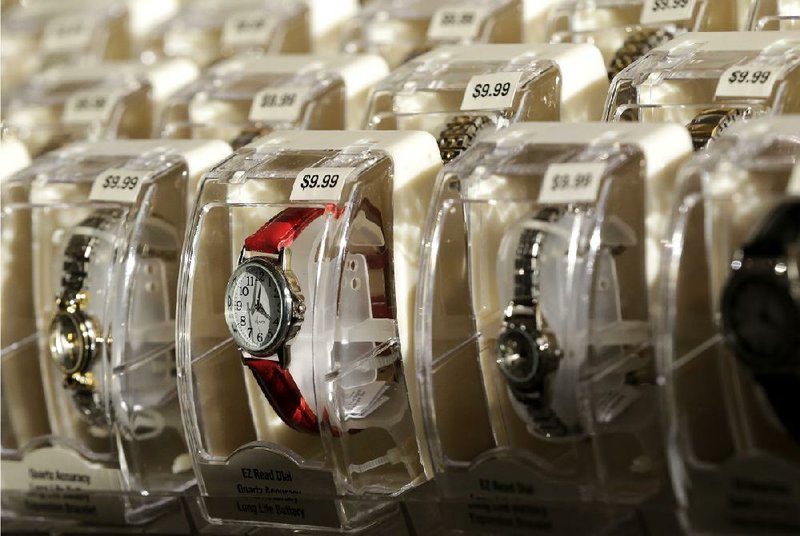The cost of living in the U.S. was unchanged in November from a month earlier, an indication that inflation is making scant progress toward the Federal Reserve’s goal.
No change in the consumer-price index followed a 0.1 percent decrease the prior month, the Labor Department said Tuesday. The median forecast of 83 economists surveyed by Bloomberg called for a 0.1 percent advance. The core measure, which excludes food and fuel, rose 0.2 percent.
“Core inflation is still running too low,” said Laura Rosner, a U.S. economist at BNP Paribas SA in New York. “We probably have further weakness to see as retailers adjust prices to reduce the stockpiles that we know boosted growth.”
American Eagle Outfitters Inc. has joined other retailers in offering more discounts to attract cash strapped shoppers this Christmas, underscoring limited cost pressures.
Fed policymakers, who began a two-day meeting Tuesday, are debating the outlook for inflation and the economy as they consider reducing $85 billion of monthly bond purchases designed to support the expansion.
Low inflation also gives Fed members more reason to hold off scaling back bond purchases for a few more months. Many economists expect the Fed to keep the purchases at that level.
“Indeed, inflation is still a distance from the Fed’s 2 percent target, and this is one report that would give the Fed reason to go easy on tapering,” said Jennifer Lee, senior economist at BMO Capital Markets.
Critics of the bond-buying program fear it will spark higher inflation.
Estimates for the consumer-price index ranged from a drop of 0.1 percent to a gain of 0.2 percent, according to the Bloomberg survey. Economists projected the core gauge would increase 0.1 percent.
Overall consumer prices rose 1.2 percent in the year that ended in November after a 1 percent year-over-year gain in October. The core CPI climbed 1.7 percent from November 2012, matching the gains in the previous two months.
Energy costs fell 1 percent from a month earlier. The decline reflected cheaper gasoline and natural gas.
Falling gasoline prices this quarter have given households the wherewithal to spend more on other goods and services. The average cost of a gallon of regular gasoline has declined to $3.23 as of Sunday from $3.39 on Oct. 1, according to AAA, the biggest U.S. motoring group. In Arkansas, the average price Tuesday was $2.98, according to AAA.
Food costs rose 0.1 percent for a second month.
New automobile prices declined 0.1 percent for a second month. Clothing prices dropped 0.4 percent after declining 0.5 percent in each of the prior two months, while home furnishing costs also declined.
Owners-equivalent rent, one of the categories designed to track rental prices, increased 0.3 percent.
American Eagle Outfitters, the Pittsburgh-based apparel company, is among businesses reducing prices to lure consumers during the busiest shopping period of the year.
“We continue to operate in the most challenging sector of retail where there has been intense promotional competition and tepid consumer spending,” Chief Executive Officer Robert Hanson said on a Dec. 6 earnings call. “Sales have been promotionally driven, which is pressuring margins.”
Researcher ShopperTrak reiterated at the end of last month a forecast it gave in September that Christmas sales will grow 2.4 percent, the smallest gain since 2009.
Hourly earnings adjusted for inflation rose 0.2 percent after rising 0.1 percent the prior month. They were up 0.9 percent over the past year.
The CPI is the broadest of three price gauges from the Labor Department because it includes goods and services. About 60 percent of the index covers prices consumers pay for services from medical visits to airline fares, movie tickets and rents.
Wholesale prices fell 0.1 percent in November, the third straight drop, according to Labor Department data released last week. November import prices declined 0.6 percent for a second month, the data showed Thursday.
A small amount of inflation can be good for the economy because it encourages consumers and businesses to spend and invest before prices rise further. But if prices don’t increase at all, consumers might pull back their spending on the expectation that goods will be cheaper in the future.
Information for this article was contributed by Michelle Jamrisko of Bloomberg News and Josh Boak of The Associated Press.
Business, Pages 25 on 12/18/2013
